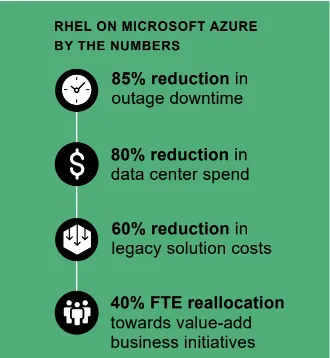Modernizing IT environments and moving workloads to the cloud is a top priority for organizations across the globe. But what exactly are the benefits to be gained and how can you make them quantifiable? What is the best approach and what are the variables that change the trajectory of a project and ultimately determine whether or not it’s successful? These are pivotal questions deserving of serious consideration.
Red Hat and Microsoft commissioned Forrester Consulting to help quantify the benefits of running Red Hat Enterprise Linux (RHEL) on Microsoft Azure. Forrester's Total Economic Impact™ (TEI) consulting practice develops business value justification analysis to help organizations understand the financial impact of a technology investment. TEI provides a rigorous cost and benefit analysis framework that incorporates future technology, business flexibility, and associated risks.
The full study includes specifics on how the combination of Red Hat Enterprise Linux and Microsoft Azure deliver unique benefits not available on every public cloud or with any Linux distribution. After the investment in Red Hat Enterprise Linux on Microsoft Azure, interviewees noted their organizations ran a hybrid cloud infrastructure that allowed them to leverage benefits of both on-premises infrastructure and cloud services while maintaining control over critical data and applications with a common tool. High level findings of the study show a 60% reduction in legacy solution costs and a 40% FTE reallocation towards value-add business initiatives for a composite organization representative of interviewed customers. The study delves into specific actions and decision points that were made strategically to offset the investment in moving to the cloud including new approaches to time-intensive tasks and re-evaluating the need for scalability.

Source: The Total Economic Impact™ Of Red Hat Enterprise Linux On Microsoft Azure
Jeremy Winter, Corporate Vice President of Azure Cloud Native at Microsoft shared his thoughts on the partnership and the specific outcomes of running Red Hat Enterprise Linux on Microsoft Azure, “Our joint customers want us to partner closely with each other. And that’s why Microsoft and Red Hat offer a variety of options to run Linux workloads across different environments, such as on-premises, edge, or other cloud providers. Microsoft and Red Hat have been co-developing several solutions that leverage the unique capabilities and strengths of both platforms. The foundation of everything we do together is Red Hat Enterprise Linux.”
Microsoft Azure brings in significant savings by reducing the reliance on an organization’s data center. The study showed an 85% reduction in outage downtime and 80% reduction in data center spend for a composite organization representative of interviewed customers. One of the most significant benefits of cloud migration is reduced infrastructure expenses. By moving applications and data storage to the cloud, organizations can eliminate costs related to hardware maintenance and upgrades. Other benefits include business continuity savings, a reduction in data center spending and staff reallocation towards value-adding initiatives.
“Red Hat Enterprise Linux on Azure is a pretty easy sell because you’re not paying for power, you’re not paying for cooling, you’re not paying for capital expenditures on the hardware, and you’re not paying for the maintenance on that hardware.”
Infrastructure Architect, Manufacturing
Gunnar Hellekson, Vice President & GM of the Red Hat Enterprise Linux Business Unit at Red Hat added that “Red Hat workloads run exceedingly well on Azure thanks to our close engineering collaboration, integrated customer support and flexible licensing options like Azure Hybrid Benefit for Linux that enable customers to run Red Hat workloads in Azure on their terms. New images of Red Hat Enterprise Linux are published almost instantly on the Azure Marketplace once we release them.”
One especially valuable benefit of using RHEL in the hybrid cloud is the performance and analytics tool, Red Hat Insights, which is included when you choose RHEL. It enables customers to use the same set of tools to administer both datacenter and cloud environments and helps reduce complex operational tasks. Insights uses predictive analytics based on decades of expertise to identify, prioritize, and remediate security and performance risks. You can also use it to build your own custom images and launch them directly to the cloud, and it was recently FedRAMP Authorized.
“We chose Red Hat because we wanted a standard level of support and updates for our production environment. As a primarily Linux shop, we had concerns about using unsupported open-source software and preferred the reliability and predictability of a commercially licensed software like Red Hat.”
Global Director of IT, Wholesale Retail
Common initiatives organizations choose to get started include:
- Migration of on-premises Red Hat Enterprise Linux workloads to Azure, often without the need to refactor applications
- Migration from Linux distributions like CentOS Linux and standardizing on Red Hat Enterprise Linux on Azure to simplify IT environments
- Ultimately, modernization and automation projects
Anyone can try Red Hat Enterprise Linux on Azure for free, by signing up for a free trial or using their Azure credits, or by bringing your existing RHEL subscriptions directly to Azure with Red Hat Cloud Access or Azure Hybrid Benefit (AHB) for Linux.
In-depth calculations can be found in the full TEI study. If you prefer to hear directly from a guest speaker from Forrester, register for our analyst webinar which also includes commentary from Red Hat and Microsoft executives on the partnership and the combined value of their respective solutions.
Resources:
Sull'autore
Melissa Lautzehiser is a Senior Principal Product Marketing Manager at Red Hat where she is responsible for the GTM strategy for Red Hat Enterprise Linux in the public cloud.
Melissa has more than 20 years of experience in B2B technology marketing. Prior to joining Red Hat, she was sole proprietor of Marketing Matters, LLC, a product marketing consulting company for small tech start-ups. She has held various product marketing roles on both the distributor side and supplier side of the high tech ecosystem including director roles at Avnet Technology Solutions (now Tech Data), Exact Software, and NetSmart Technologies.
Altri risultati simili a questo
Ricerca per canale
Automazione
Novità sull'automazione IT di tecnologie, team e ambienti
Intelligenza artificiale
Aggiornamenti sulle piattaforme che consentono alle aziende di eseguire carichi di lavoro IA ovunque
Hybrid cloud open source
Scopri come affrontare il futuro in modo più agile grazie al cloud ibrido
Sicurezza
Le ultime novità sulle nostre soluzioni per ridurre i rischi nelle tecnologie e negli ambienti
Edge computing
Aggiornamenti sulle piattaforme che semplificano l'operatività edge
Infrastruttura
Le ultime novità sulla piattaforma Linux aziendale leader a livello mondiale
Applicazioni
Approfondimenti sulle nostre soluzioni alle sfide applicative più difficili
Serie originali
Raccontiamo le interessanti storie di leader e creatori di tecnologie pensate per le aziende
Prodotti
- Red Hat Enterprise Linux
- Red Hat OpenShift
- Red Hat Ansible Automation Platform
- Servizi cloud
- Scopri tutti i prodotti
Strumenti
- Formazione e certificazioni
- Il mio account
- Supporto clienti
- Risorse per sviluppatori
- Trova un partner
- Red Hat Ecosystem Catalog
- Calcola il valore delle soluzioni Red Hat
- Documentazione
Prova, acquista, vendi
Comunica
- Contatta l'ufficio vendite
- Contatta l'assistenza clienti
- Contatta un esperto della formazione
- Social media
Informazioni su Red Hat
Red Hat è leader mondiale nella fornitura di soluzioni open source per le aziende, tra cui Linux, Kubernetes, container e soluzioni cloud. Le nostre soluzioni open source, rese sicure per un uso aziendale, consentono di operare su più piattaforme e ambienti, dal datacenter centrale all'edge della rete.
Seleziona la tua lingua
Red Hat legal and privacy links
- Informazioni su Red Hat
- Opportunità di lavoro
- Eventi
- Sedi
- Contattaci
- Blog di Red Hat
- Diversità, equità e inclusione
- Cool Stuff Store
- Red Hat Summit

